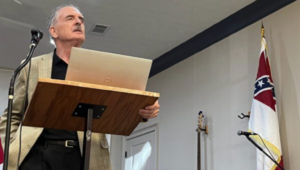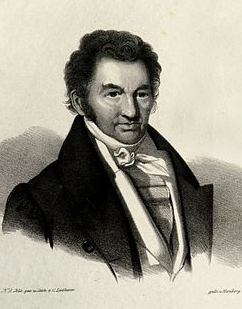To contextualise this series about psychiatry, see: here. Below, an abridged translation of a chapter of one of the books that I wrote in 2000 (I added the triple parentheses this year):
A student-led panel discussion sponsored by NAMI
In NAMI’s website I saw the photo of Justin, a four-year-old boy with a suppliant expression on his face. The website says:
Meet Justin—a child with a mental illness.
Justin was diagnosed with OCD (obsessive compulsive disorder) which made it difficult for him to succeed in school. Today medication helps Justin to attend classes with his peers and avoid the uncontrollable behaviors he previously experienced. [1]
At the end of “Perpetrators and psychiatrists: an obscene alliance” I had mentioned an organization of family parents which calls itself National Alliance on Mental Illness(NAMI). Since this book deals with parents and psychiatrists, it is pertinent to delve a little deeper into this organisation of parents that, with the help of psychiatrists, has labelled and medicated thousands of children and adolescents during family conflicts. In recent times NAMI has gained such power in American society that I must speak out about what it is doing to little boys like Justin, even though I have to stomach the largest string of psychiatric lies and Newspeak propaganda that I know.
Following next I quote some passages from NAMI’s web site as I found it on the internet in May 2000. Let us read with attention NAMI’s lies. The following quotation is from NAMI’s book reviews, It’s Nobody’s Fault by (((Harold Koplewicz))), a bioreductionist psychiatrist of children and teenagers in a medical center of New York:
It’s Nobody’s Fault could not have been written 25 years ago.
It reflects the monumental change that has taken place in understanding all mental illnesses—that they are brain disorders, disturbances in brain chemistry and nobody’s fault. The work deals with serious brain disorders in children and adolescents […].
Koplewicz is “must reading” for parents who feel guilty and remorse about the brain disorder of a child. [2]
The truth is that NAMI does not approach genuine brain diseases such as epilepsy, the stroke or brain cysticercosis, but of those invented by psychiatrists. NAMI’s list includes: “schizophrenia, bipolar disorder (manic-depressive illness), major depression, obsessive compulsive disorder [the label on little Justin] and severe anxiety disorders”[3]— “disorders” similar to drapetomania, dyasthesia Aethiopica, nymphomania, kleptomania and moral insanity to the psychiatric mind of other times.
In “Things you should know: NAMI facts”, this organization states who are the target of these labels: “Most often, severe mental illnesses are diagnosed in young people between the ages of 16-25”.[4] More extraordinary is to learn of the political goals of NAMI on these youngsters:
GOAL: NAMI will be recognized as the primary source for information and helpful referral on all aspects of mental illness.
GOAL: The general public will understand that mental illnesses are non-fault, biologically based, treatable, and may eventually be curable. [5]
Another goal of NAMI is to increase its membership “to at least one million families by the year 2000”.[6] Most significant of the folie à deux between these families and NAMI can be seen in a 1998-1999 NAMI poll to 900 parents. It showed that more than half of the polled parents said their GPs didn’t recognise the mental diseases that the polled parents believed to see in their offspring. [7]
In other words, according to NAMI the parents, not the medical doctors, are the ones to diagnose biomedical diseases. This is what Jeffrey Masson said above about the “identified” child by his parents: that a psychiatrist implied that parents did not err in home diagnoses and even quoted scholarly psychiatric journals to support his claim. Similarly, NAMI uses the word “identifying” alluding children.[8] NAMI’s blindness is such that even when they have evidence from physicians that home conflicts can disturb emotionally a child, they proclaim the biological cause of the disturbance:
Parents [of said poll] perceived that most professionals and services had not kept current with the latest research or treatment information and used outdated theories and approaches, including blaming families for their child’s disorder.
“I took my son to a psychiatrist who said if we, parents, stopped fighting with each other, my son would be fine. It was our own fault”. [9]
NAMI quotes these words as proof that the physician had not subscribed the latest fashion of biological reductionism, discarding the possibility that this fighting between mom and dad could affect the emotional state of the child. Other parents stated:
“The biggest issue we faced during the time our daughter began to manifest problems (when she was five years old) was to convince the ‘professionals’ that she did indeed have a disease that was biologically based and not caused by alleged child abuse [or] bad parenting”. [10]
Is there another field beside the psychiatric where an organisation dares to air in every direction that the parents know more of biomedical symptoms than medical doctors?
In addition to these pediatricians it is revealing that some people who know these polled parents are under the impression that the parents might have something to do with their children’s mental state. This is inferred from the same information in the NAMI poll. To the statement “I often feel that others blame me for my child’s condition”, 29 percent of the polled marked “Strongly agree”, 21 percent “Agree” and 20 percent “Partially agree”. That is, 70 percent of those who actually know these parents may suspect a parental etiology of the problem. However, nothing more annoys NAMI that “the injustice of outright parent-blaming”. [11]
NAMI claims that “as many as 8 to 10 percent of all Americans suffer from severe mental illness, and as many as 1 in 5 families are affected”.[12] NAMI also claims that mental illnesses “affect about 20 percent of children and adolescents”[13] and that “an estimated 7.5 million children [in America], 12 percent of all children under age 18, have mental disorders”.[14] It is amusing to observe that this last figure contradicts the quoted before. Laurie Flynn, NAMI’s director, claims that “two-plus million Americans suffering from schizophrenia today receive substandard care”.[15]
As some critics have pointed out, psychiatrists, and now this organisation of “concerned” family parents not only invent diseases: they invent epidemics too.
Incredibly, an organisation that sees epidemics has started to influence American politics. NAMI has carried out successful campaigns in several states of the United States, with the support of local judges and social workers, to force children to take drugs against their will and without the need to commit them in the hospital. The New York Times estimates that in the year 2000 more than 4,000 outpatients in New York state will be given psychiatric drugs against their will due to NAMI and the new law.[16]
How is it possible that NAMI has obtained such power and influence? According to the periodical Mother Jones, from 1996 to 1999 eighteen drug firms donated more than ten million dollars to NAMI: Janssen ($2.08 m), Novartis ($1.87 m), Pfizer ($1.3 m), Abbot Labs ($1.24 m), Wyeth-Ayerst ($658,000), Bristol-Myers Squibb ($613,000) and Eli Lilly & Co., which among other drugs manufactures Prozac ($2.87 m).[17] This is evidence of the obscene alliance between abusive parents, psychiatrists and the forces of the free market.
The existence of organisations such as NAMI exhibits psychiatry as what it has always been: a fraudulent profession composed by mercenary pseudo-scientists that always plead for the interests of parents. NAMI’s goals (“The Nation’s Voice on Mental Illness” says its logotype) of controlling, stigmatise and medicate their rebellious children are so open that I must continue to quote them:
NAMI’s Policy Goals: An increase in federal funding for research in House and Senate appropriation bills—emphasizing / targeting children […].
Extensive and meaningful involvement of psychiatrists trained in child and adolescent psychiatry in the diagnosing and treatment—including residential treatment [involuntary hospitalisation] […].
To identify at least three federal government policy barriers which obstruct treatment of childhood serious mental illness. Then to advocate appropriate federal Congressional and Administration policies responding to such barriers.[18]
The lie NAMI repeats the most, that even the editors of the DSM would be embarrassed to iterate so many times, is that these children have “biological brain disorders”, for instance when NAMI advocates medication against their will.[19] This strongly reminds me what Solzhenitsyn observed: that in Stalin’s age there was no official communication in the Russian press that didn’t lie in some way about a propaganda statistic or social affair.[20] But let’s continue to listen to the Americans:
NAMI believes that children and adolescents with brain disorders have the right to thrive in nurturing environments, that all children and adolescents with brain disorders deserve to have early diagnoses with appropriate treatments.[21]
Orwell could not have said it better in the black-white Newspeak of the Ministry of Love. If NAMI manages to accomplish its political goals, the image that comes to my mind is similar to one of 1984: a parent in the future stepping on with both feet the child’s face and looking down in the name of his nurture, diagnosis and treatment.
I would like to annotate this essay on the nature of evil in mankind, in which I’ve already included many quotations, with two more quotations. Orwell wrote:
Twelve voices were shouting and they were all alike. No question, now, what had happened to the faces of the pigs. The creatures outside looked from pig to man, and from man to pig, and pig to man again; but already it was impossible to say which was which. [22]
Tom Szasz quoted this passage of Animal Farm in one of his books because he fears that with time the Soviet Communist State and the American Therapeutic State could be undistinguishable. The other quotation is a letter of resignation of the renowned psychiatrist Loren Mosher. Mosher was the chief of the Center for Studies of Schizophrenia in the National Institute of Mental Health (1968-1980). He wrote the following letter to the president of the American Psychiatric Association, Dr. Rodrigo Muñoz:
December 4, 1998
Dear Rod:
After nearly three decades as a member it is with a mixture of pleasure and disappointment that I submit this letter of resignation from the American Psychiatric Association. The major reason for this action is my belief that I am actually resigning from the American Psychopharmacological Association. Luckily, the organization’s true identity requires no change in the acronym […].
This is not a group for me. At this point in history, psychiatry has been almost completely bought out by the drug companies. The APA could not continue without the pharmaceutical company support […].
No longer do we seek to understand whole persons in their social contexts, rather we are there to realign our patients’ neurotransmitters. The problem is that it is very difficult to have a relationship with a neurotransmitter whatever its configuration.
So, our organization provides a rationale, by its neurobiological tunnel vision, for keeping our distance from the molecule conglomerates we have come to define as patients […]. It saddens me that after 35 years as a psychiatrist I look forward to being dissociated from such an organization. In no way does it represents my interests. It is not within my capacities to buy into the current biomedical-reductionistic model heralded by the psychiatric leadership as once again marrying us to somatic medicine. This is a matter of fashion, politics and, like the pharmaceutical house connection, money.
In addition, APA has entered into an unholy alliance with NAMI (I don’t remember the members being asked if they supported such an organization) […] the two organizations have adopted similar public belief systems about the nature of madness. While professing itself the champion of their clients the APA is supporting non-clients, the parents, in their wishes to be in control, via legally enforced dependency, of their mad / bad offspring. NAMI, with tacit APA approval, has set out a pro-neuroleptic drug and easy commitment-institutionalization agenda that violates the civil rights of their offspring. For the most part we stand by and allow this fascistic agenda to move forward […].
The shortsightedness of this marriage of convenience between APA, NAMI and the drug companies (who gleefully support both groups because of their shared pro-drug stance) is an abomination. I want no part of a psychiatry of oppression and social control […].
Finally, why must the APA pretend to know more than it does? DSM IV is a fabrication upon which psychiatry seeks acceptance by medicine in general. Insiders know it is more a political than a scientific document […]. The issue is what do the categories tell us? Do they in fact accurately represent the person with a problem? They don’t, and can’t, because there are no external validating criteria for psychiatric diagnoses. There is neither a blood test nor specific anatomic lesions for any major psychiatric disorder[emphasis added]. So where are we? APA as an organization has implicitly (sometimes explicitly as well) bought into a theoretical hoax […].
We seem to have forgotten a basic principle: the need to be patient / consumer satisfaction oriented. I always remember Manfred Bleuler’s wisdom: “Loren, you must never forget that you are your patient’s employee”. In the end they will determine whether or not psychiatry survives in the service marketplace.
Sincerely,
Loren R. Mosher, M.D.
This confession of an apostate of psychiatry shows that there are good people everywhere, even in that profession. Unfortunately, they are not the majority.
__________
[1] (In 2019 this pageis no longer available.)
[2] (In 2019 this pageis no longer available.)
[3] (In 2019 this pageis no longer available.)
[4] (In 2019 this pageis no longer available.)
[5] Ibid.
[6] Ibid.
[7] (In 2019 this pageis no longer available.)
[8] Ibid.
[9] Ibid.
[10] Ibid.
[11] (In 2019 this pageis no longer available.)
[12] (In 2019 this pageis no longer available.)
[13] (In 2019 this pageis no longer available.)
[14] (In 2019 this pageis no longer available.)
[15] (In 2019 this pageis no longer available.)
[16] The New York Times (8 April 1999).
[17] I obtained this information thanks to a web site critical of psychiatry. (In 2019 this pageis no longer available.)
[18] (In 2019 this pageis no longer available.)
[19] See for example “NAMI’s Policy on involuntary commitment”. (In 2019 this pageis no longer available.)
[20] The Gulag Archipelago (op. cit.), pp. 325f.
[21] (In 2019 this pageis no longer available.)
[22] Thomas Szasz’s quotation are the last words of Orwell’s Animal Farm. In The Therapeutic State (op. cit.) the citation appears on page 237, in a chapter devoted to comparing Soviet with American psychiatry, with detriment to the latter. The image of the feet on the face as a symbol of soulless oppression appears in what O’Brien said to Winston in the Ministry of Love (Nineteen Eighty-Four, op. cit., p. 211).
______ 卐 ______
Liked it? Take a second to support this site.









